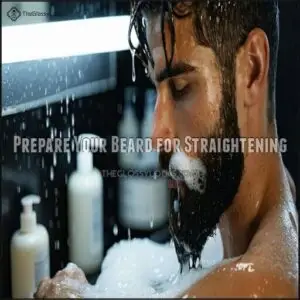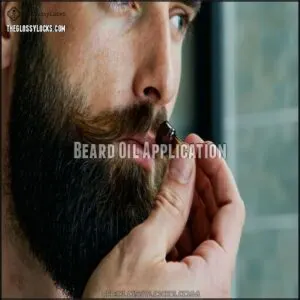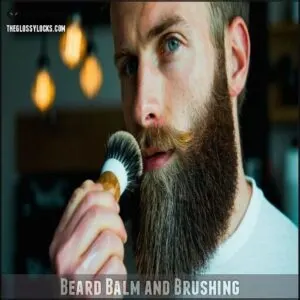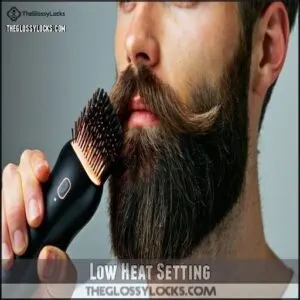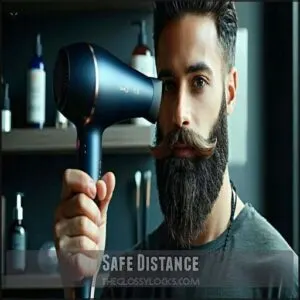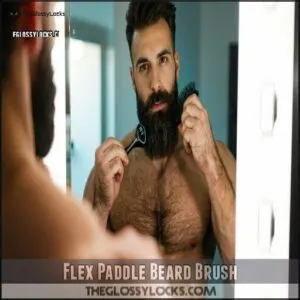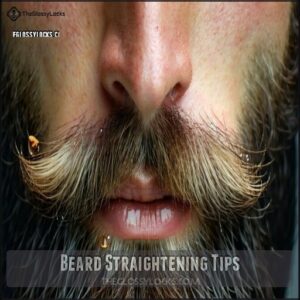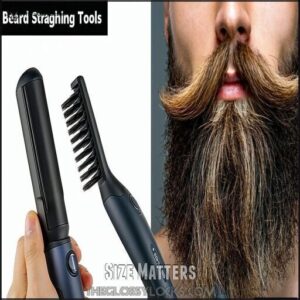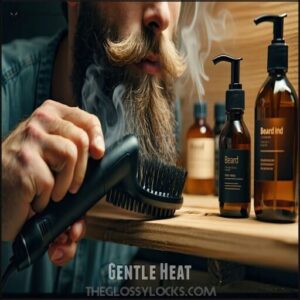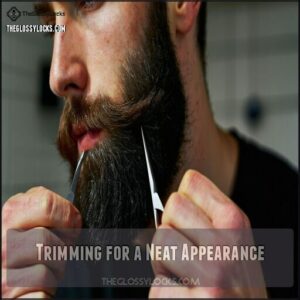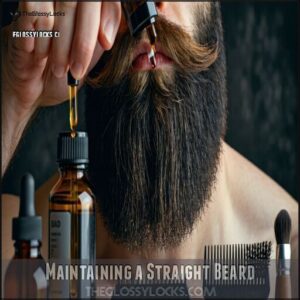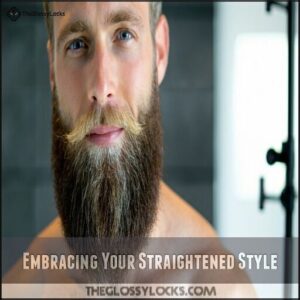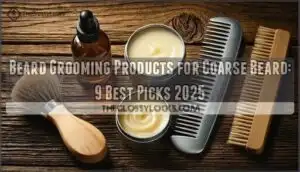This site is supported by our readers. We may earn a commission, at no cost to you, if you purchase through links.
 To straighten your beard, start by washing it with a quality beard shampoo and conditioner to soften and detangle the hair.
To straighten your beard, start by washing it with a quality beard shampoo and conditioner to soften and detangle the hair.
Apply beard oil after drying to lock in moisture and prevent frizz. Work in a small amount of beard balm for added control and shape, then brush downward using a boar bristle brush.
For extra sleekness, use a blow dryer on a low heat setting with a paddle brush, keeping the dryer a safe distance to avoid damage. If needed, a narrow flat iron can help, but use it sparingly.
With regular care, your beard will stay smooth and tidy.
Table Of Contents
- Key Takeaways
- Prepare Your Beard for Straightening
- Beard Oil Application
- Beard Balm and Brushing
- Heat Styling for a Sleek Look
- Training and Maintenance
- Beard Straightening Tips
- Using a Flat Iron for a Straight Finish
- Trimming for a Neat Appearance
- Maintaining a Straight Beard
- Embracing Your Straightened Style
- Frequently Asked Questions (FAQs)
- What is a beard straightener?
- How to prepare your beard before using a beard straightener?
- How much does a beard straightener cost?
- Do beard straighteners really work?
- How do I get my beard to grow straight?
- How can I make my beard softer?
- Are all beards curly?
- How do you fix a curly beard?
- How do I train my beard to lay flat?
- How can I make my beard hair straight?
- Conclusion
Key Takeaways
- Wash your beard with lukewarm water and a specialized beard shampoo, then apply conditioner to soften and detangle it.
- Apply beard oil daily to hydrate, reduce frizz, and protect your beard before straightening.
- Use a blow dryer on low heat with a paddle brush or a heated beard straightener to gently style your beard.
- Trim stray hairs regularly and brush your beard daily to maintain a neat, sleek, and well-shaped appearance.
Prepare Your Beard for Straightening
Getting your beard ready for straightening is essential to achieving the best results.
Start by washing and conditioning your facial hair to remove dirt, soften strands, and make the beard easier to manage, which helps in achieving the best results.
Washing and your beard lays the foundation for smooth, manageable grooming and styling success. Smooth beards start with clean care.
Wash and Condition Your Facial Hair
Washing and conditioning your beard lays the foundation for great grooming. Start with a beard wash designed to clean without stripping natural oils. Follow it up with a hydrating conditioner to soften and detangle.
Use lukewarm water—hot water strips moisture, and cold water won’t clean well. Rinse thoroughly, then pat dry with a towel to avoid breakage.
A quality routine starts with a specialized beard cleanser. Here’s your checklist:
- Opt for quality products formulated for facial hair.
- Adjust water temperature to protect moisture.
- Dry gently to keep your beard smooth and frizz-free.
Beard Shampoo and Conditioner Benefits
A strong start to beard straightening begins with a proper beard care routine.
Quality beard shampoo keeps dirt, grease, and itchiness at bay, while beard conditioner adds a essential hydration boost, ensuring softness enhancement and manageability improvement.
Struggling with dandruff? These products tackle it, leaving your beard and skin healthy.
Don’t compromise—cheap, harsh shampoos strip natural oils, making growth less healthy.
Instead, use nourishing options designed for facial hair.
They smooth the way for a sleek, straightened beard and make grooming easier.
A well-cared-for beard sets the stage for effective styling and long-lasting results.
Hydration and Nourishment
A hydrated beard is a happy beard. Hydration doesn’t just prevent dryness—it’s a game-changer for beard care and styling.
Start with beard oil, packed with essential oils, to provide deep conditioning, improve beard moisture, and enhance shine. Follow up with beard balm, rich in natural butters, to lock in hydration and tackle unruly strands.
Applying these products after a shower, when your beard is soft, guarantees better absorption and long-lasting results. Consistency is key—hydrating daily keeps your beard nourished and easier to straighten.
Here’s your hydration essentials:
- Beard oil for deep conditioning and shine.
- Beard balm to smooth and shape.
- Use post-shower for best results.
- Products with essential oils and vitamins for nourishment.
- Maintain daily hydration for beard health.
Detangling and Manageability
Tackling tangles is key to a sleek, manageable beard. Before grabbing your heated beard brush or beard straightener, focus on detangling. Use a wide-tooth comb or boar bristle brush, as these tools minimize pulling and protect Beard Density.
Comb from the ends upward to safely remove knots. Applying beard oil or a quality detangler before brushing softens hair, making it more manageable. Straight, smooth strokes in your beard’s growth direction work best, setting the groundwork for effective beard styling.
Daily brushing prevents knot buildup and enhances manageability. Here’s a quick guide:
| Action | Benefit |
|---|---|
| Wide-tooth comb | Reduces Knot Prevention |
| Apply beard oil | Softening Techniques |
| Avoid pulling | Preserves Beard Density |
| Comb ends first | Product Buildup reduction |
| Smooth strokes | Tames beard effectively |
Beard Oil Application
Applying beard oil keeps your facial hair hydrated, smooth, and easier to manage for straightening.
Use a few drops daily, especially after a shower, to lock in moisture and tame flyaways.
Hydration and Smoothness
Moisture is the secret weapon for a manageable, sleek beard.
Moisture transforms your beard, turning rough strands into a smooth, sleek style that’s easy to manage and maintain.
If your facial hair feels rough or uncooperative, hydration is key.
That’s where beard oil plays a starring role.
Packed with nourishing ingredients like argan and jojoba oils, these products lock in moisture, tame flyaways, and leave your beard soft and touchable.
After washing, place a few drops of beard oil into your palms and massage it thoroughly into your beard, focusing on the skin underneath.
This step reduces itchiness, prevents beard dandruff, and preps your hair for straightening.
For added smoothness, pair it with a moisturizing balm or beard heat protectant.
Hydrated hair responds better to styling tools like a heated beard brush or straightener, giving you a well-styled, polished beard that stays sleek all day.
Daily Application
Consistency is the backbone of your daily beard care routine.
Start each morning by applying a few drops of beard oil to your hands and rubbing them together.
Then, massage the oil into your beard, facilitating it reaches the skin underneath.
This improves daily hydration while softening your beard, making it ready for effortless styling.
Next, grab a quality comb to spread the product evenly.
Wide-tooth wooden combs work best as they minimize breakage and pull.
Routine consistency guarantees your facial hair stays nourished, manageable, and tidy throughout the day, giving you smooth beard straightening results.
For midday touch-ups, carry a travel-sized beard straightener brush.
Pair it with a beard heat protectant for safe and effective grooming anywhere.
- *Tip: Regular use of beard oil keeps dryness and frizz in check, offering long-term benefits for beard grooming and styling.
Post-Shower Application
After a warm shower, your beard is at its best for styling.
Pat it gently with a towel until it’s damp but not dripping—this is key for proper Towel-Dry Timing. Use this perfect Dampness Level to massage beard oil or straightening cream into the hair.
This step boosts Product Absorption, reducing Post-Shower Itch and making styling simpler. A damp, clean beard allows oils to distribute evenly.
Finish by using a beard comb or beard brush to shape and set your style, preventing a stubborn wet beard look.
Healthier Growth
Applying beard oil after your shower isn’t just a luxury; it’s essential for your beard’s health and growth.
Beard oil keeps your beard follicles strong and your skin hydrated, building a foundation for healthier, thicker hair.
Here’s how it supports growth:
- Boost Nutrient Intake: Oils packed with vitamins improve scalp health and fortify hair follicles.
- Hydration Effects: Prevents dryness for smoother, softer facial hair.
- Reduce Breakage: Protects against split ends and thinning.
- Healthy Follicles: Creates an ideal environment for consistent beard care progress.
Taming Flyaways
Struggling with wild beard flyaways? After a shower, your warm beard and open pores are the perfect starting point.
Take a few drops of beard oil and rub them between your palms. Massage it into your beard, working from roots to tips for Static Reduction and Split Ends prevention. Focus on your edges to keep them sharp and smooth.
Comb the oil through evenly to guarantee Root Direction alignment and to tame your beard effectively.
If stubborn frizz won’t quit, add a dab of beard balm for Humidity Control and stronger hold.
For the ultimate sleek finish, pair the balm with a heated beard straightener. Don’t skip beard heat protectants to avoid damage or Product Buildup.
Beard Balm and Brushing
Using beard balm and a brush is essential for taming stubborn hairs and shaping your beard.
The balm softens and conditions, while brushing evenly distributes it and trains your beard to grow in the desired direction.
Beard Balm Application
After your shower, pat your beard till it’s slightly damp—this is the sweet spot for applying balm.
Scoop a dime-sized amount of beard balm and rub it between your palms until it melts smoothly. Massage it from the roots to the tips, making sure every strand absorbs the goodness.
- Balm Ingredients: Look for natural components like beeswax and shea butter for moisture and tame flyaways.
- Hold Strength: Helps lock your style in place, even on hectic days.
- Styling Effects: Softens coarse hair, giving you manageable, polished straightening results.
Beard balm is one of the must-have beard care products for easier styling! Many users discover benefits of beard balm after consistent use.
Brushing Technique
Brushing your beard is key to mastering beard straightening techniques. Use a boar bristle brush to gently detangle and reduce snags.
Start against the grain to spread balm evenly, then brush with the grain to set the beard’s direction. Apply steady brush pressure for better control, working in sections for precision.
Brush angles matter—adjust as needed for hard-to-reach areas. Consider different options for your brush.
For enhanced results, pair brushing with heated brushes or a blow dryer on low heat. This helps achieve smooth, polished beard straightening results effortlessly, using a boar bristle brush.
Beard Training
Think of beard training like guiding wild vines into a tidy garden—it takes patience, but it’s worth it.
After using balm, grab a boar bristle brush and gently comb your beard in the desired direction.
This step, part of consistent grooming, works wonders for shaping techniques and reinforcing growth patterns.
Over time, it helps tame stubborn hairs and tricky cowlicks, improving the beard’s texture.
Pair this with styling aids, and you’ll find it easier to straighten your beard and maintain its sleek look.
Regular brushing acts like a workout for your beard, helping stubborn strands learn their place while laying the groundwork for advanced beard straightening techniques.
Hair Follicle Stimulation
A well-groomed beard starts with stimulating your healthy follicles, ensuring improved circulation and enhanced nutrition to each hair strand.
Daily brushing with a boar bristle brush promotes accelerated growth and reduced breakage, keeping your beard stronger and fuller. Pair that with a beard balm, and you’re shielding your beard from heat damage and maximizing follicle health.
Here’s how to optimize this process:
- Brush daily using a boar bristle brush for improved circulation.
- Apply balm to lock in moisture and prepare for beard heat tools.
- Massage evenly for nourishment.
- Stay consistent for enduring results when using beard straighteners or a beard heat shield.
Shape and Control
Achieving a well-groomed, straight beard starts with mastering shape and control. A high-quality balm is your secret weapon, helping to tame stubborn cowlicks, smooth directional growth, and lock in a polished look throughout the day.
Warm a dime-sized amount of balm between your hands, rubbing it into your beard from roots to tips. Work slowly, ensuring even coverage. Then, grab your natural bristle brush to evenly spread the product while defining edges and improving beard symmetry.
Beard balm also helps set the style but additionally preps your facial hair for beard straighteners and other styling tools.
Here’s why it’s essential:
- Softens coarse hair for easier shaping
- Provides long-lasting styling product hold
- Tames cowlicks and unruly sections
- Helps manage beard for a symmetrical finish
- Enhances precision when you straighten your beard
Heat Styling for a Sleek Look
To achieve a sleek, straight beard, you’ll need the right tools and careful technique.
Using low heat, a blow dryer, and a flex paddle brush guarantees smooth results without damaging your beard.
Blow Dryer Use
Using a blow dryer to straighten your beard can transform your grooming routine. Start by softly towel-drying—hard rubbing causes frizz—letting your beard air-dry slightly. Before using heat, apply a beard heat protectant to shield against damage.
Set your blow dryer to a low or medium heat setting. Attach a nozzle to focus airflow and hold the dryer about six to ten inches (optimal dryer distance) from your beard. Pair it with a flex paddle beard brush for control.
Brush in the direction your beard naturally grows, following the air’s flow to smooth hairs evenly and prevent tangles.
- Quick Straight Beard Tip: Always aim downward airflow to avoid lifting or roughening the hair.
Take it slow and finish with a cold air blast to lock in your style and prevent damage.
Low Heat Setting
Protect your beard by embracing gentle heat settings during styling.
Low temperatures reduce damage, safeguard hair follicles, and keep your skin healthy while achieving a sleek look.
Here’s a failproof approach:
- Set your heat tool to its lowest heat setting to minimize damage and protect your beard’s texture.
- Hold the tool around three inches from your beard for safe temperatures and controlled heat distribution.
- Apply a quality heat protectant to create a barrier, ensuring even heat application as you straighten your beard.
Following these straight beard tips preserves your beard’s health and makes styling effortless.
Safe Distance
Keep your blow dryer about three inches from your beard to prevent burns and maintain follicle health.
This safe distance guarantees even heating without causing heat damage to your skin or hair.
Pair this technique with low heat settings and quality beard tools for effective results.
Treat your beard with care—it’s more fragile than it looks!
Flex Paddle Beard Brush
A flex paddle beard brush is one of the best beard styling tools for taming unruly whiskers. Its flexible base adjusts perfectly to the contours of your face, making it easy to manage and straighten your beard while keeping grooming comfortable.
Pair this brush with low heat from a blow dryer for a sleek finish that’s quick and effortless. Flexibility in the brush guarantees better detangling performance, reduces snagging, and even gives a gentle scalp massage-like sensation for beard care.
Here’s how to get the most out of it:
- Pick a brush with strong, heat-resistant bristle material.
- Use adjustable settings on your blow dryer for better control.
- Clean the brush regularly to maintain detangling performance.
- Apply beard straightening creams for added smoothness and volume.
- Store it in a cool place for longer-lasting use.
Training and Maintenance
Training your beard takes patience and the right tools to keep it looking neat and straight.
Regular trimming, using a boar bristle brush, and avoiding damaging habits are essential for maintaining its health and shape.
Regular Trimming
After you straighten your beard, regular trimming is key to keeping it sharp and polished.
Trimming goes beyond cutting—it’s about maintaining symmetry, managing growth, and defining your style.
Stray hairs and split ends can distract from your beard’s sleek look, but a quick beard trim restores order.
- Invest in quality tools: Use beard scissors or a trimmer for precise beard grooming.
- Trim regularly: Base trims on your beard’s growth rate for consistent style maintenance.
- Shape for balance: Match your beard to your facial structure for a clean, defined appearance.
Boar Bristle Brush
A boar bristle brush is an essential tool in your beard-care arsenal, transforming your routine from ordinary to exceptional.
Its natural bristles offer the perfect balance of stiffness and softness, making it ideal for daily straightening and grooming.
Here’s how to maximize its benefits:
- Brush Daily: Tame your beard by brushing daily to train hair direction and reduce flyaways. Use consistent, gentle movements.
- Match Products: Apply a quality beard oil or balm before brushing to enhance bristle glide and lock in moisture.
- Prioritize Quality: Look for brushes with durable wood handles and high-quality bristles for better control and longevity.
- Clean Regularly: Maintain your brush with proper cleaning methods, removing trapped oils or debris for continued effectiveness.
This brush simplifies men’s grooming and guarantees a sleek, tamed beard effortlessly.
Avoid Damaging Habits
Hair damage happens when you over-style, twist, or straighten your beard without caution.
Wet Beard straightening is especially harmful—always dry it first.
Avoid Excessive Heat; use ceramic iron straighteners or low settings for better beard protection.
Constant Over-Straightening or Infrequent Washing can weaken strands, while Product Buildup dulls your look.
Treat your beard gently with heat styling only when necessary, think of it as crafting art, not rushing a chore.
Overnight Care
A good nighttime beard routine prevents waking up to a frizzy mess. Start by massaging a few drops of beard oil or applying an overnight balm to hydrate and soften your beard as you sleep. This step locks in moisture and reduces morning dryness.
Switch to silk pillowcases to minimize friction and protect your beard from unnecessary breakage. If your beard tangles easily, consider a loose protective braid or using a beard wrap for added maintenance.
- Keeps your beard hydrated all night
- Prevents knots, frizz, and split ends
- Makes beard styling effortless in the morning
- Boosts the effects of quality beard products
Consistent care like this guarantees a healthier, easier-to-manage beard.
Beard Straightening Tips
Straightening your beard requires the right tools, techniques, and care to achieve a sleek look without causing damage.
From using a blow dryer with a brush to applying oil for hydration, each step matters in taming unruly facial hair.
Hot Water Wash
Use warm water, not too hot or cold, as the first step in prepping your beard for straightening. Warm water softens tough curls, opens hair cuticles, and makes your beard much easier to manage.
Keep the water temperature comfortable to protect your skin and hair from damage while washing. Massage your beard as you wash—this simple step boosts skin hydration and improves circulation, a vital part of beard grooming.
Use a mild beard shampoo to remove oil buildup, dirt, and leftover product for a fresh start. Wash your beard two to three times a week, depending on your lifestyle, to avoid over-drying.
After washing, make sure to dry your beard completely before moving on to straightening tools. This step is crucial for the overall health and appearance of your beard, ensuring you get the best results from your beard care routine.
Oil-Based Hydration
After washing your beard with hot water, give it the care it craves using beard oils like argan oil.
A few drops massaged into the skin beneath your beard can transform coarse hair into something manageable and smooth.
- Boosts hydration levels, keeping hair soft.
- Controls flyaways, delivering a well-groomed appearance.
- Improves shine, enhancing your beard’s natural texture.
This simple application technique supports beard conditioning as well as nourishes the skin, reducing dryness and irritation.
Butter for Softness
If your beard feels rough and unruly, consider adding beard butter to your routine—it’s like a deep conditioner for your facial hair.
Packed with shea butter, cocoa butter, and nourishing oils, beard butter doesn’t just hydrate—it transforms. These ingredients tackle dryness, soften coarse hairs, and leave your beard easier to manage.
You’ll love how it makes styling simpler while enhancing your beard’s overall health. It loosens tight curls and smooths out frizz, making it perfect for straightening or taming your beard.
Beard butter is also known to provide natural, soothing ingredients for superior beard health.
- Deep hydration: Keeps beard soft and prevents dryness.
- Hair conditioning: Enhances manageability and shine.
- Daily ease: Makes beard maintenance quick and effective.
Apply a fingertip-sized amount to a damp beard, massage it in, and enjoy long-lasting beard softness and shine.
Brush Regularly
Brushing regularly is key to training your beard to stay smooth, neat, and well-behaved.
By detangling knots and distributing natural oils, a brush helps condition your beard while encouraging growth in the right direction.
It’s more than grooming—it’s beard maintenance for long-term results.
Choose a brush with boar bristles for superior performance.
Bristle selection matters because these brushes gently tame your beard without causing damage.
Stick to consistent brushing frequency—once or twice daily is enough.
Overdoing it can lead to breakage or frizz, so keep it balanced.
Brushing also provides styling benefits, making your beard easier to manage and shape.
Add it to your grooming tips, and you’ll tame your beard while paving the way to easily straighten a beard.
Simple and effective!
Blow Dryer Boost
A blow dryer can work wonders for a sleek, straightened beard when used right.
Follow these steps for a polished look:
- Control Heat Damage: Set to low heat and keep a three-inch distance for safe drying.
- Refine Technique: Comb as you dry for even volume control and direction.
- Seal the Style: Finish with cool air for style longevity.
Using a Flat Iron for a Straight Finish
A flat iron can be a great tool for achieving a straight, polished beard when used carefully.
Stick to a mini flat iron with adjustable heat settings, and always work in small sections to protect your beard from damage.
Size Matters
The right tool dimensions can make straightening your curly beard much easier.
For shorter beards or areas like your jawline, a mini flat iron is your best friend.
Its narrow plate width allows for precision, so you can tackle tricky spots while avoiding burns.
The compact handle length also makes it easier to maneuver around contours.
Longer beards need more coverage, and wider plates work better here.
A straightener with proper bristle spacing helps distribute heat evenly, making it easier to manage coarse or dense hair.
Avoid bulky flat irons meant for head hair—they’re too aggressive for facial hair and hard to control.
Match the straightener to your beard length and thickness.
If your beard manageability is a problem, the right tool fixes that effortlessly.
Combine it with a beard trimmer to tidy stray hairs, and you’ll have a neat, sleek look.
Gentle Heat
A sleek, straight beard starts with careful heat management. Set your beard heat setting low to minimize damage while straightening. High temperatures can weaken facial hair, so prioritize temperature control and pair it with a heat protectant to shield against breakage.
Use a proper technique to maintain healthy hair:
- Keep the straightening iron gliding; don’t pause on sections.
- Begin gently at the roots, pulling through to the tips.
- Mini straightening brushes work wonders for precise areas.
- Use straightening tools sparingly for better long-term results.
With infrequent use and attention to detail, your beard will stay smooth and well-styled.
Less is More
Less is more when straightening your beard. Overdoing it with heat or products can strip your beard of moisture, leaving it dry and brittle.
A minimal approach protects your beard’s natural texture while keeping it healthy and manageable. Stick to gentle styling tools and techniques for the best results.
- Use minimal product: Opt for a quality heat protectant and a simple beard straightener brush.
- Straighten infrequently: Avoid daily use; less frequent straightening guarantees a healthier beard.
- Enhance natural texture: Focus on taming unruly parts instead of forcing a pin-straight look.
Follow these beard care tips to maintain a sleek, natural-looking beard with ease. For short beards, consider using heated comb straighteners for best results.
Trimming for a Neat Appearance
Trimming helps keep your beard neat and prevents stray hairs from disrupting your straightened style.
By focusing on a clean shape, you’ll create a polished look that’s easier to maintain.
Trim Stray Hairs
A neat beard starts with regular trimming. Focus on stray hair removal to keep your beard sharp and polished.
Use precision trimming tools for clean lines and maintaining beard shape—this will enhance your overall beard style. Trim frequently to prevent split ends and tame your beard effectively.
For instance, using the search-and-destroy method can help target individual stray hairs.
Pay special attention to shaping your neckline and edges, as these small details can elevate your beard appearance. By keeping stray hairs in check, you’ll find it easier to straighten your beard and maintain a well-groomed, confident look.
Prevent Disruption of Style
Preserving your beard style takes smart choices and simple steps.
After trimming stray hairs, protect your work by focusing on longevity and control.
- Snip precisely using sharp scissors or a trimmer to maintain balance and tame the beard’s edges.
- Apply wax in light layers, focusing on product layering for a strong hold against humidity.
- Enhance overnight protection with a beard wrap or oil, shielding against frizz.
These beard techniques keep your straighten beard smooth and polished, ensuring your style lasts all day.
Maintaining a Straight Beard
Keeping your beard straight requires regular attention to brushing and hydration to maintain its shape and prevent frizz.
Use high-quality products that suit your beard’s texture, and stick to a consistent grooming routine for the best results.
Daily Brushing
After trimming, daily brushing keeps your beard looking polished and promotes healthy growth. It’s not just about appearances—regular brushing trains your beard to follow a consistent growth direction, helping tame cowlicks and unruly strands.
Use tools that suit your beard texture, like boar bristle brushes for a thicker beard, or wooden combs for smoother, even strokes. Brushing also prevents breakage by evenly distributing natural oils, leaving your beard shiny and controlled.
To further enhance beard health, consider that regular exercise benefits the beard. Make brushing a routine part of your beard care—it only takes minutes to prevent tangles, tame your beard, and maintain a sleek, straightened look without compromising your style.
Regular Hydration
Healthy beards need moisture to look their best.
Regular hydration improves beard health while keeping hair soft and manageable.
- Drink enough water daily to support your beard care routine.
- Use beard oil for moisture retention and smoothness.
- Apply beard conditioners with natural product ingredients for extra nourishment.
- Stick to a consistent hydration frequency to maintain beard moisture and promote long-lasting beard health.
Experiment With Products
Taming your beard requires experimenting with products that complement your straightening process.
Incorporate tools that add control and refinement while protecting your beard’s health.
- Beard Relaxing Creams: These soften curls and ease the straightening process.
- Beard Wax for Hold: Excellent for locking in a sleek, styled look.
- Detangler Use: Makes combing through coarse hair simple and hassle-free.
- Oil for Shine: Nourishes and adds a polished finish.
Mix and match products to suit your routine.
Pair them with a beard straightener or balm conditioning for that polished beard transformation.
Embracing Your Straightened Style
Knowing how to maintain and enjoy your straightened beard makes a big difference in showcasing your style.
Explore methods that work best for you, and remember that confidence comes from feeling comfortable with your look.
Find Your Perfect Method
Finding your ideal straightening process takes time, but it’s worth it.
Compare straightener types—beard comb straighteners, flat iron straighteners, or heated brushes—matching them to your beard length and needs.
Use a blow dryer or rounded brush for control, pairing these tools with straightening creams or beard oils to lock in smoothness.
Pick techniques that feel right for your daily routine.
| Beard Tool | Best For | Benefits | Drawbacks |
|---|---|---|---|
| Beard Comb Straighteners | Short to medium beards | Easy control, even heat | Limited for long beards |
| Flat Iron Straighteners | Long beards | High precision | Requires careful handling |
| Heated Brushes | All beard lengths | Quick, versatile results | Less precision than flat irons |
| Straightening Creams | All beard lengths | Smooth texture, hydrating | Temporary results only |
Don’t Be Afraid to Ask for Help
You don’t have to tackle beard straightening alone. Getting guidance is smart and empowering.
Here’s how:
- Professional Barber Advice: Barbers can share expert beard styling advice and product recommendations.
- Online Beard Community Support: Join forums where men exchange grooming tips.
- Styling Technique Guidance: Ask a friend experienced with taming beards.
- Overcoming Embarrassment: Others have faced this—ask confidently knowing these connections build mastery!
Confidence is Key
Owning your beard’s transformation means embracing your newfound beard confidence.
Straightening is more than mens grooming—it’s self-expression. Let your personal style reflect that.
- Self-Esteem Boost: A sleek, straight beard projects confidence and a positive image.
- Inner Strength: Grooming becomes a ritual of empowerment.
- Own It: Beard care advice is key, but your belief in yourself tames even the wildest beard.
Frequently Asked Questions (FAQs)
What is a beard straightener?
Think of a beard straightener as your beard’s best wingman.
It’s a heated tool—like a mini hairbrush or comb—designed to tame unruly beard hairs, leaving them smooth, neat, and easier to style.
How to prepare your beard before using a beard straightener?
Start by washing and completely drying your beard.
Trim for a manageable shape, then comb gently to detangle.
Apply beard oil to soften and protect against heat. This guarantees a smooth, damage-free straightening process.
How much does a beard straightener cost?
You get what you pay for—quality beard straighteners typically cost $30-$
Avoid cheap models under $10 as they often fail to deliver results.
Investing in a reliable tool saves time, effort, and frustration.
Do beard straighteners really work?
Yes, beard straighteners work when you choose the right tool for your beard type and follow proper techniques.
Using heat responsibly with grooming products like oils or balms guarantees a sleek, natural, damage-free finish.
How do I get my beard to grow straight?
Straightening starts with preparation—trim and wash your beard, then dry it fully.
Use a heated brush or flat iron with low heat, applying beard oil for protection.
Comb daily and style with wax for lasting results.
How can I make my beard softer?
Use a beard conditioner daily, followed by applying a quality beard oil to lock in moisture.
Comb your beard using a wooden comb, and rinse weekly with a mild beard shampoo for long-lasting softness.
Are all beards curly?
Picture your beard as a forest—each one unique.
Not all beards are curly; textures vary wildly.
While genetics play a big role, some manage straight or wavy beards, often requiring less effort to style and maintain.
How do you fix a curly beard?
Start by trimming excess fluff, then apply beard oil to soften.
Use a heated straightener brush or blow dryer with a round brush, pulling hair downward gently.
Finish with a balm or wax for hold.
How do I train my beard to lay flat?
Taming a wiry beard is like training a wild horse—consistency is key.
Comb it daily with a boar bristle brush, apply beard oil for softness, and blow-dry while brushing downward to set it flat.
How can I make my beard hair straight?
Straighten your beard by starting with clean, dry hair.
Apply heat protectant, then use a heated straightener brush, gently gliding through in sections.
Follow with beard balm or wax to lock in the style.
Conclusion
Nearly 67% of men with beards say proper grooming boosts their confidence.
Straightening your beard isn’t just about looks—it keeps it healthy and manageable.
Start by washing and conditioning regularly, apply beard oil for hydration, and use balm to shape. Brush daily with care and, if needed, use low heat tools sparingly.
Consistent trimming and hydration help maintain your style. Follow these tips, and you’ll enjoy a sleek, tidy beard that looks and feels great, with the added benefit of boosting confidence.
- https://livebearded.com/blogs/do-better/how-to-straighten-a-curly-beard
- https://madvikingbeard.com/blogs/the-viking-blog/how-to-straighten-beard
- https://www.tiege.com/blogs/news/how-to-straighten-your-beard
- https://www.reddit.com/r/AskMen/comments/okpc69/how_do_you_shapestraighten_your_beard/
- https://cremocompany.com/blogs/blog/straighten-your-beard

